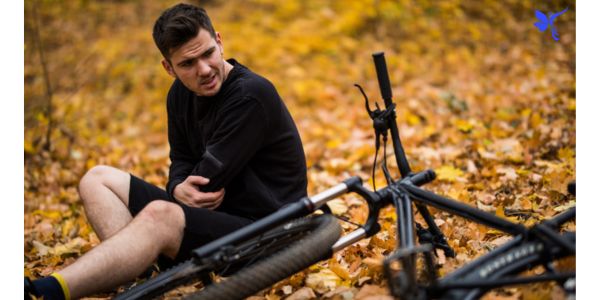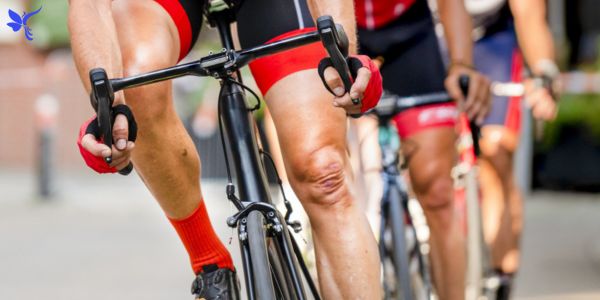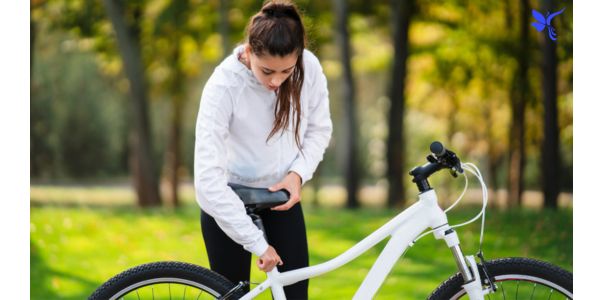Beyond doubt, pedaling a bicycle presents a remarkable way to boost your heart health and build robust physical power. However, for many dedicated riders, especially those covering long distances, elbow pain cycling can become a significant issue. Such an ache, frequently called “Cyclist’s Elbow” or sometimes even “Tennis Elbow,” can become a real bother, making it tough to stay active.
This detailed guide will explore what causes this pain, its common signs, smart ways to prevent it, and proven steps to make your elbow feel better, all focused on discomfort from cycling. We aim to provide clear insights on how to overcome this specific repetitive strain injury and get you back to pain-free cycling with confidence.
Understanding Elbow Pain in Cyclists
Elbow pain often casts a long shadow over cycling enjoyment. This troublesome issue, commonly dubbed “Cyclist’s Elbow” or sometimes “Tennis Elbow,” results from an injury caused by repetitive strain. It specifically targets the tendons located around your elbow, particularly the lateral epicondyle, which is that prominent bony bump on the outside.
This specific injury develops from many small, repeated hurts to the tendons that link your forearm muscles directly to your elbow joint. While typically associated with racquet sports, the prolonged grip on handlebars and awkward arm positioning during rides can equally provoke this specific cycling elbow pain.
Common Symptoms of Cyclist’s Elbow

Recognizing the early signs of Cyclist’s Elbow is very important for quick action. You might first notice a persistent, burning pain on the outer part of your elbow. This discomfort often spreads downward, extending through your forearm toward your wrist.
Furthermore, expect some swelling or tenderness directly around the elbow joint. You might also feel reduced grip strength, and simple wrist movements could make your pain much worse. Ignoring these early signs risks developing chronic pain and more serious tendon damage.
Primary Causes of Elbow Pain While Cycling
Understanding what causes your cycling elbow pain is the crucial first step toward relief. Several factors often combine to bring about this discomfort for cyclists, each needing your careful attention and understanding. Pinpointing these causes can greatly help your prevention strategy.
Repetitive Motion and Overuse
Cycling demands a constant, firm grip on the handlebars. This continuous action places relentless repetitive stress on the muscles and tendons in your forearm. Over time, this constant action can create tiny tears in the tendons, leading to pain and inflammation around the elbow joint. It is a classic overuse injury.
Poor Bike Fit and Setup
A poorly fitted bike often acts as a silent cause of elbow pain. If your bike frame is too big or too small, or your handlebar position is wrong, it forces you into bad riding posture. This awkward position then puts too much strain directly on your elbows. This strain gets even worse during long rides or when you cycle on bumpy roads.
Improper Riding Posture and Arm Position
Holding the proper riding posture is extremely important for stopping elbow pain cycling. Those who ride with their arms locked straight or place too much body weight onto their hands and wrists create extra pressure on their elbow joints. This incorrect form can also lead to other issues, like neck and shoulder pain. Think of your elbows as shock absorbers.
Impact from Rough Terrain
Riding on rocky or very uneven surfaces greatly increases the vibrations sent through your handlebars to your elbows. These repeated shocks may lead to inflammation and irritation in your tendons. Over time, these repeated shocks will certainly worsen any existing elbow pain cycling. It is a significant factor in biker’s elbow.
The Impact of Poor Bike Fit on Elbow Health

A misaligned bike fit is a major contributor to elbow pain cycling. When your reach is too long or your handlebars are positioned improperly, your body compensates. This compensation often involves locking your elbows or hyperextending your wrists, leading to undue strain on the joint.
This incorrect setup means your arms cannot properly act as shock absorbers. Instead, every bump and vibration directly pounds your elbow joints, leading to cumulative tendon damage and potential repetitive strain injury over time. Getting a professional bike fit is truly a smart move.
Preventing Elbow Pain Through Bike Adjustments
Proactive adjustments to your bicycle are your best defense against elbow pain cycling. A professional bike fit is an invaluable tool. It ensures your saddle height, handlebar position, and overall reach align perfectly with your unique body. This fine-tunes your riding posture, giving you the most comfort and best efficiency on the bike.
Consider adjusting your handlebars to allow a slight, natural bend in your elbows. This subtle bend helps to absorb road shocks, reducing direct pressure on your elbow joints. Additionally, using ergonomic grips or padded gloves can provide extra cushioning, safeguarding your hands and elbows from impact and strain.
Essential Strengthening Exercises for Cyclists
Building strong forearm muscles and shoulder musculature fortifies your body against repetitive stress injuries. Incorporate targeted strength work that specifically strengthens your forearm muscles, such as wrist curls and reverse wrist curls. These exercises help to directly support the elbow joint.
Furthermore, do not neglect your shoulder stabilizers and rotator cuff. Exercises like external rotations using elastic bands improve shoulder stabilization exercises. A strong upper body provides a stable platform, reducing compensatory strain on your elbows during rides and preventing elbow pain cycling.
Warm-Up and Stretching Routines to Prevent Injury
Preparing your muscles before each ride is a truly non-negotiable ritual. A thorough warm-up primes your body, while light stretching enhances flexibility. Focus on gentle stretches for your forearms and wrists, as well as your shoulders and neck.
This pre-ride preparation increases blood flow and improves tissue elasticity. It significantly reduces the likelihood of repetitive strain injury and helps avoid sudden inflammation. Think of it as carefully oiling the gears before a long journey, preventing any grinding discomfort.
Immediate Steps for Managing Elbow Pain
When elbow pain cycling flares up, prompt action is critical. The first step involves reducing or temporarily stopping the activity that triggers the discomfort. Resting the affected arm allows inflammation to subside and the tendons to begin mending properly.
Applying an ice pack to the tender area for 15-20 minutes, several times daily, helps diminish swelling and numb the pain. Using compression wraps can also provide supportive relief, gently reducing fluid buildup around the elbow joint. This initial pain relief is vital.
When to Seek Professional Medical Help
While self-care often manages mild cases of Cyclist’s Elbow, some situations absolutely demand expert intervention. If your elbow pain cycling persists or worsens despite rest and home remedies, it is definitely time to consult a medical help professional.
Seek help if you experience significant swelling, a noticeable decrease in your elbow’s range of motion, or if the pain truly affects your daily activities. Early diagnosis and a personalized treatment plan can prevent chronic pain and speed up your recovery. Consider visiting a physical therapist.
Understanding and Treating Cycling-Related Tendonitis

Cycling can bring two main types of elbow tendonitis. Lateral epicondylitis, widely known as “Tennis Elbow,” brings pain to the outside of your elbow. This frequently flares up when you squeeze something firmly or raise your wrist. It occurs from repeated shocks traveling up your handlebars to the tendons of your wrist and elbow, as noted by sources like Johns Hopkins Medicine.
On the other hand, medial epicondylitis, also called “Golfer’s Elbow” or “Baseball Elbow,” results in pain on the inner elbow, especially when straightening your arm. This is caused by inflammation of tendons that connect to muscles controlling finger flexing and downward wrist turns. Both conditions are forms of biker’s elbow.
Comprehensive Recovery Strategies for Biker’s Elbow
Overcoming Biker’s Elbow demands a holistic, patient approach. Recovery is not a sprint; it’s a marathon for your muscles and tendons. Combining several strategies ensures a robust return to pain-free cycling, addressing the root causes.
Reduce the Training Load
Healing truly begins with intelligent restraint. Temporarily reducing your training load or completely pausing activities that aggravate your elbow pain cycling is absolutely necessary. This crucial step provides your inflamed tendons the essential rest needed to start their repair process and prevent further tendon damage. This allows the inflammation to settle down.
Work with a Physical Therapist
A skilled physical therapist becomes your essential guide on the recovery journey. These experts will pinpoint exactly what brings on your repetitive strain injury, then craft a unique treatment plan specifically for you. This often includes soft tissue massage, manual therapy, and carefully progressing exercises to strengthen and heal. Many sports-related injuries benefit greatly from this expert guidance.
Use Cold Compression Therapy
Applying focused cold compression therapy provides a strong answer for inflammation and pain relief. Special devices, such as PowerPlay’s elbow wrap, when connected to a compression pump and a reusable cold therapy gel pack, deliver steady cooling and gentle squeezing to the area. This method significantly reduces swelling and discomfort, accelerating the healing process without mess. It serves as a superb method of treatment that doesn’t involve surgery.
Focus on Strengthening the Muscles and Tendons
Strength work forms the strong foundation of lasting recovery. Correcting muscle imbalances, especially in your shoulder musculature and forearm muscles, holds great importance. Eccentric contraction focused exercises for wrist extensors, alongside shoulder stabilization exercises using elastic bands, rebuild resilience. This prevents future occurrences of elbow pain cycling by correcting underlying weaknesses.
Take Your Time
When your tendons are healing, patience is absolutely needed; it’s more than just a good trait. Rushing back to full activity too soon risks transforming an acute injury into a more serious, chronic pain condition. Allow ample time for complete healing to prevent long-term discomfort or even osteophyte (bone spur) formation. Your body needs this time to truly repair.
Optimizing Your Road Bike to Prevent Upper Limb Pain

Fine-tuning your road bike is a real game-changer for preventing upper limb discomfort, especially elbow pain cycling. Carefully check your handlebar width; if it’s too wide or too narrow, it can seriously strain your shoulders and neck, pulling on your elbows. Also, ensure your brake levers and hoods are comfortably within easy reach.
Furthermore, assess your saddle tilt and saddle height, along with saddle layback. These subtle adjustments significantly impact how much weight you unconsciously bear on your hands, directly influencing the strain on your elbows. A professional bike fit is truly a worthwhile investment for lasting comfort and pain relief.
Riding Smart: Long-Term Prevention of Cycling Elbow Pain
Sustaining a pain-free cycling life requires ongoing vigilance and smart habits. Consistently apply proper form and technique, maintain a balanced training load, and prioritize adequate rest and recovery. Think of this as an ongoing conversation with your body, where you listen and respond.
Regularly incorporate strength work and stretching into your routine, even when you feel no pain. Basic principles like getting quality sleep and honoring rest days are crucial. By embracing a holistic approach to your cycling health, you can enjoy countless miles on the open road, completely free from the shackles of elbow pain cycling.
Conclusion
Elbow pain cycling can indeed be a very vexing companion on your rides, but it is certainly not an insurmountable obstacle. By deeply understanding its common causes, diligently applying preventative measures, and embracing comprehensive treatment strategies, you can truly reclaim your comfort. Remember, a well-fitted bike, proper riding posture, and dedicated strengthening are your most powerful allies in this journey. Embrace these crucial insights, and you will soon be pedaling with renewed vigor and fantastic freedom.
FAQ
How to quickly fix elbow pain?
Rest the affected arm, apply an ice pack to reduce inflammation, and consider over-the-counter pain relievers.
Can cycling aggravate tennis elbow?
Yes, cycling can certainly aggravate tennis elbow due to repetitive grip and arm strain on the handlebars.
What are red flag symptoms of tennis elbow?
Red flags include severe pain, significant swelling, numbness, or inability to perform daily activities.
Will tennis elbow go away?
Yes, with proper rest, treatment, and rehabilitation, tennis elbow often resolves.
How do I stop my elbow from hurting when cycling?
Ensure a proper bike fit, adjust your riding posture, and incorporate strengthening and stretching exercises.
What is a bikers elbow?
Biker’s elbow is a common term for lateral epicondylitis or medial epicondylitis (golfer’s elbow) caused by cycling-related repetitive strain.
